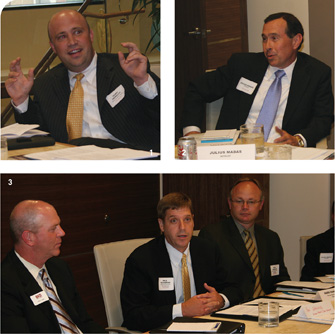
1: "Innovation," said Henry Heimsoth, violated the fundamentals of sound lending practices. | 2. Julius Madas echoed the comments of many bankers in assessing the pressures that were coming to bear on banking revenues. | 3. Paul Holewinski, center, said he feared that the net effect of Dodd-Frank was "a first step toward regulation of banks as utilities."
As in any other lawsuit, First Community bank President Greg Bynum observed, trial lawyers will find regulations that contradict each other and work the angles. “So even if you treated the customer fairly, and used common sense,” said Bynum, “it won’t have common sense once you get it to court.”
Henry Heimsoth thought it would have been interesting to have invited politicians to the meeting. He wanted to ask them, “So really, what is the goal of this regulation?” As Heimsoth explained, a bank’s role is to deploy capital. All agree that such deployment is necessary to kick-start the economy, but these regulations just make it harder to do that.
BKD partner Lyle Alexander, whose client base runs the gamut from large banks to small thrifts, wondered when all was said and done, “How my clients are going to make money with the squeezed margins.”
Interchange Fee Amendment
Before moving on, Kevin Cook summed up his take on the “too big to fail” and “level playing field” questions: “Yes, the tools are there to implement it, but I hear a lot of skepticism as to whether the enforcement will be there, or whether polices will be enforced once they are there.”
“Being the accountant in the room,” he wondered how the interchange fee amendment would affect the profitability of the banks, and how the bankers anticipated adapting to that.
“I think it’s just the first step in banks becoming a regulated utility,” said Paul Holewinski, CEO of the Dickinson Financial Corp. As he explained, the language of the interchange fee amendment suggests that only the Fed would determine the fees on credit card and debit card exchanges and, then only enough to cover the banks’ costs.
“That’s obviously going to result in reduced revenues for the banks,” Paul Holewinski noted, “and it’s going to result in reduced services for our customers.”
The legislation does now have an explicit provision so that banks can factor in fraud,” said Chuck Morris of the Federal Reserve. But, he conceded, “It is really vague what you mean by setting standards for what you judge reasonable and proportional.”
Julius Madas, executive vice president of INTRUST Bank, believes that the Senate Banking Committee caved in to retailer pressure from companies like Wal-Mart, with the understanding that the retailers were going to pass the savings on to the consumer. “I don’t think that’s going to occur at all,” said Madas. As he explained, banks have absorbed the risk of fraud. “We’ve developed the technology that’s made their business better and safer,” he said, “and essentially this is going to minimize our revenue stream.”
John Dicus wondered what the regulation of credit card fees had to with the crisis of 2008. He sees the maneuver as a way to pass legislation that otherwise would not get passed. “If you go back, the things they really needed to address,” he said of Congress, “they didn’t address them.”
For Mark Hargrave, the question was how banks would make up for the lost revenue. Would they have to move to a la carte pricing on all services including heretofore free checking.
Trust-Preferred Securities
These are hybrid debt and equity securities issued by banks as a way of raising capital. Under Dodd-Frank, they will likely wither away as a useful financial instrument. Asked Mike Lochmann: “How do you square the demands coming out of Washington—why aren’t the banks making more loans?—with the economic reality that you just wiped out, or you’re about to wipe out a whole category of capital.”
Greg Bynum sees the demands as incompatible. “I think people are going to have to accept having an 8 percent return on equity instead of 12,” he said.